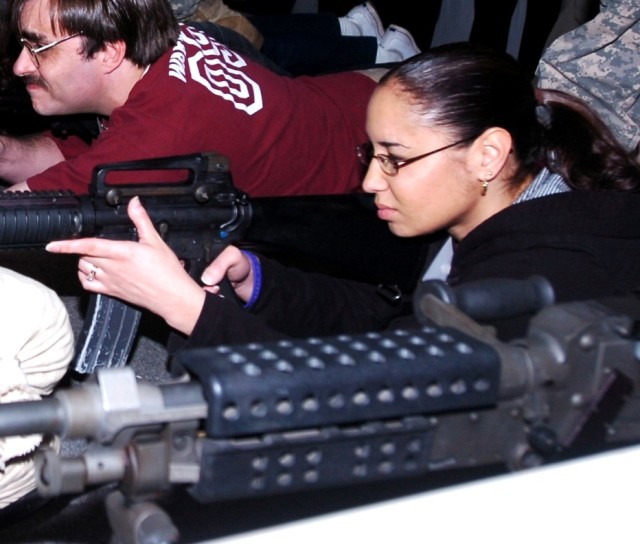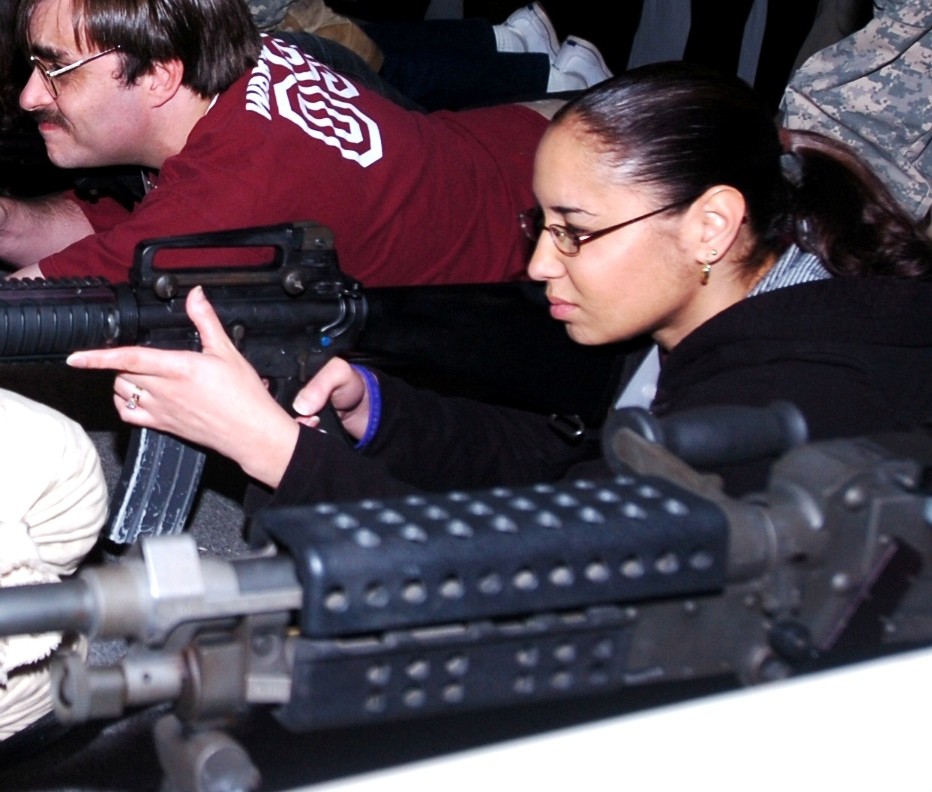FORT HOOD, Texas - Tina Flores-Nevarez, a human resource generalist for Texas A&M University - Central Texas, assumed the prone, held the rifle close and engaged targets on the large 12-foot screen in front of her.
Like Flores-Nevarez, more than 40 other staff and students from TAMU-CT took part in a day-long exploration of some of Fort Hood's training simulators March 4.
With the new campus scheduled to open in the fall of 2012, the tour was an opportunity for the staff and students of the university to gain first-hand knowledge of how Soldiers on Fort Hood train and what they do on a daily basis, said Dr. Steve Vitucci, the director of military programs and military relations for TAMU-CT.
"The visit helps them [staff and students] understand the culture of the military," he said.
The day started with a briefing to discuss the day's events, the partnership between the post and TAMU-CT and a brief history of Fort Hood, said Dr. Lisa Bunkowski, an associate professor of history at TAMU-CT
The visitors then split into two groups for each of the three simulation programs. During the brief for the close combat tactical trainer, Roger Trevino, a tactical training senior professional for the CCTT explained to the group on the purpose, benefits and strategic advantages of using simulators for training Soldiers.
In addition to saving funds on fuel, ammunition and parts, simulators offer a wide variety of opportunities for Soldiers to train, calculate risk and review results faster. The greatest advantage is the fact that mistakes can be made and lessons learned which helps reduce casualties during war.
"We want them [the Soldiers] to make mistakes in the simulator so they don't die in real operations," said Trevino.
The simulators have been quite effective, said Staff Sgt. Gary Pearson, a Riverside, Calif. native and platoon sergeant for the 3rd Squadron, 3rd Armored Cavalry Regiment. He not only instructed three platoons from the 3rd Sqdn. but also a few of the visitors from TAMU-CT.
One of Pearson's pupils during the visit was Gaylene Nunn, a Temple, Texas native and chief financial officer for TAMU-CT. She said this visit was very informative and educational.
Having done a tour on Fort Hood once before, Nunn said this tour was more in depth and a lot more fun.
Being more in depth and having a hands-on approach through the simulators was key to gaining a better understanding of the Soldiers she teaches, said Bunkowski.
Even having taught hundreds of Fort Hood Soldiers and having had a son assigned to Fort Hood, Bunkowski never had an opportunity to really see what Soldiers actually do or how stressful training can be, she said.
"It was nice to come here [the simulators] and be physically present. It was a very positive experience," said Bunkowski.
The experience helped Flores-Nevarez as well. Being a former military spouse, she said she only saw one side to her husband's work. The tour helped her receive a better understanding of what her husband went through during his time in the Army.
The experiences and knowledge taken from the tour reassured the staff and students of how hard Soldiers work to balance their careers and education, said Bunkowski. It was that dedication of the Soldiers and knowing they are trained so well that makes her feel comfortable and safe to be on Fort Hood.
The overall success of the visit led many of the staff and students from TAMU-CT to inquire about future tours that may be made available on Fort Hood.


Social Sharing